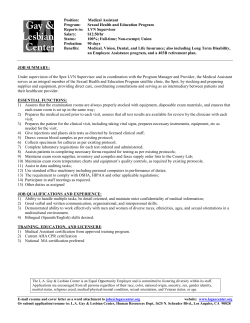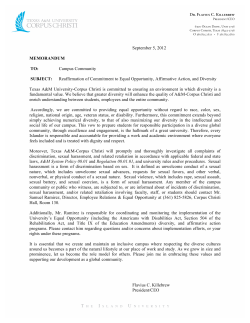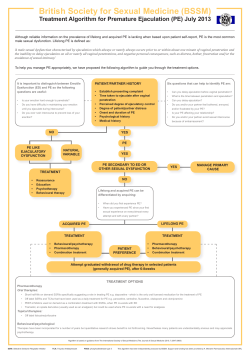
ARTICLE IN PRESS
G Model RIAM-273; No. of Pages 4 ARTICLE IN PRESS Rev Iberoam Micol. 2014;xxx(xx):xxx–xxx Revista Iberoamericana de Micología www.elsevier.es/reviberoammicol Mycologic Forum Sexual variability in Histoplasma capsulatum and its possible distribution: What is going on? Mauro Medeiros Muniz a,∗ , Carolina Nascimento Sousa a , Manoel Marques Evangelista Oliveira a , Claudia Vera Pizzini a , Marcos Abreu Almeida a , Gabriela Rodríguez-Arellanes b , Maria Lucia Taylor b , Rosely Maria Zancopé-Oliveira a a b Instituto de Pesquisa Clínica Evandro Chagas, IPEC/FIOCRUZ, Rio de Janeiro, Brazil Departamento de Microbiología y Parasitología, Facultad de Medicina, Universidad Nacional Autónoma de México (UNAM), México D.F., Mexico a r t i c l e i n f o Article history: Received 27 August 2013 Accepted 1 October 2013 Available online xxx Keywords: Histoplasma capsulatum MAT1 locus Idiomorphs Genetic diversity Latin America a b s t r a c t Histoplasma capsulatum is a dimorphic fungal pathogen naturally found in the soil. Inhalation of conidia can result in pulmonary histoplasmosis and, in some cases, causes severe disseminated disease and death. This fungus is an ascomycete that has an anamorphic or asexual stage and a teleomorphic or sexual stage, known as Ajellomyces capsulatus, which results from (+) and (−) mating types. Sexual reproduction is regulated by a specialized genomic region known as the mating-type (MAT1) locus. The mating process in this heterothallic species is represented by isolates that contain only one of the two different MAT1 locus idiomorphs (MAT1-1 or MAT1-2) that have unrelated sequences encoding different transcription factors. In medically important dimorphic pathogens and in most ascomycete molds, one MAT locus idiomorph encodes a high-mobility-group (HMG) box-domain transcription factor, and the other idiomorph encodes an alpha-box domain transcription factor. There is scarce molecular information about H. capsulatum mating type although recombinant population structures have been reported that could occur in nature and this process has been documented in distinct models such as parasites and other fungi. In this review, we shall focus on published studies on H. capsulatum sexuality, and outline the distribution of the two H. capsulatum mating types in Latin America. This manuscript is part of the series of works presented at the “V International Workshop: Molecular genetic approaches to the study of human pathogenic fungi” (Oaxaca, Mexico, 2012). © 2013 Revista Iberoamericana de Micología. Published by Elsevier España, S.L. All rights reserved. Variabilidad sexual de Histoplasma capsulatum y su posible distribución: fundamento r e s u m e n Palabras clave: Histoplasma capsulatum MAT1 locus Idiomorfos Diversidad genética Sudamérica Histoplasma capsulatum es un patógeno fúngico, dimórfico que habita en suelos ricos en materia orgánica. La inhalación de los conidios puede inducir histoplasmosis pulmonar y, en algunos casos, enfermedad diseminada grave y la muerte. Este ascomiceto caracterizado por un estadio anamórfico asexual y un estado teleomórfico o sexual, conocido como Ajellomyces capsulatus, que es consecuencia de los tipos de apareamiento (MAT+ y MAT−) (mating-type, por sus siglas en inglés). La reproducción sexual está regulada por una región genómica especializada, conocida como locus MAT1. El proceso de apareamiento en esta especie heterotálica (o autoincompatible) está representado por aislamientos que solo contienen uno de los 2 diferentes idiomorfos del locus MAT1 (MAT1-1 y MAT1-2), que tienen secuencias muy distintas que codifican diferentes factores de transcripción. En los patógenos dimórficos importantes desde un punto de vista médico y en la mayoría de los ascomicetos filamentosos, un idiomorfo del locus MAT codifica el dominio-caja HMG (high-mobility-group, por sus siglas en inglés) de un factor de transcripción, y el otro idiomorfo codifica el dominio-caja alfa de otro factor de transcripción. Apenas disponemos de información molecular sobre el mating type de H. capsulatum, aunque se ha descrito que en la naturaleza podrían estar presentes estructuras de población recombinante. Este proceso se ha documentado en distintos ∗ Corresponding author. E-mail addresses: mauro.muniz@ipec.fiocruz.br, muniz44@gmail.com (M.M. Muniz). 1130-1406/$ – see front matter © 2013 Revista Iberoamericana de Micología. Published by Elsevier España, S.L. All rights reserved. http://dx.doi.org/10.1016/j.riam.2013.10.002 Please cite this article in press as: Muniz MM, et al. Sexual variability in Histoplasma capsulatum and its possible distribution: What is going on? Rev Iberoam Micol. 2014. http://dx.doi.org/10.1016/j.riam.2013.10.002 G Model RIAM-273; No. of Pages 4 2 ARTICLE IN PRESS M.M. Muniz et al. / Rev Iberoam Micol. 2014;xxx(xx):xxx–xxx modelos como parásitos y otros hongos. En esta revisión nos hemos centrado en los estudios publicados sobre la sexualidad de H. capsulatum, y hemos abordado la distribución de los 2 mating type de H. capsulatum en Sudamérica. Este manuscrito forma parte de la serie de artículos presentados en el «V International Workshop: Molecular genetic approaches to the study of human pathogenic fungi» (Oaxaca, México, 2012). © 2013 Revista Iberoamericana de Micología. Publicado por Elsevier España, S.L. Todos los derechos reservados. Pleomorphism is a characteristic normally found in dimorphic fungal pathogens of the family Ajellomycetaceae represented by asexual and/or sexual reprodution.35,40 Asexual reproduction in species of this fungal family is represented by hyphal fragmentation or conidia production in specialized hyphae or by budding in the yeast form. For the sexual cycle, the first step of mating in members of the Ajellomycetaceae family is ascocarps production by hyphal constriction of different mating type cells coiling to one another several times until reaching ascocarps formation. After hyphal aggregations, the cleistothecium is formed with ascus, harboring meiosporic spores.20 Sexual reproduction, followed by meiosis and recombination, is a powerful event in eukaryotes in terms of evolution by increasing genetic diversity and, in some cases, generating novel genotypes with altered virulence.14,25,28 Populations of the pathogenic fungus Histoplasma capsulatum have been shown to recombine in nature.4 This process has been documented in other models, such as the parasite Toxoplasma gondii,13,34 and may have occurred also in the fungus Cryptococcus gattii during the Vancouver Island outbreak.8 Understanding the structure of fungal mating type loci is important to clarify the evolutionary processes involving these genomic structures.3,10,16,38 Sexual reproduction is regulated by a specialized genomic region known as the mating type (MAT1) locus that usually contains genes for one or more transcription factors with structural motifs.6,7,9,39 The MAT locus has two idiomorphic regions; the MAT1-1 idiomorph encodes an alpha-domain transcription factor, whereas the MAT1-2 idiomorph encodes a high-mobility-group (HMG) domain transcription factor. These domains confer sexual identity to a haploid cell6,11 ; the alpha domain (MAT1-1) or HMG domain (MAT1-2) idiomorphs determine (+) and (−) strains, respectively. Despite the available information regarding MAT1 locus structures, there is scarce information regarding the Onygenales, one of the most medically important order of fungi, including a number of dimorphic primary pathogens, such as H. capsulatum, Paracoccidioides brasiliensis, Paracoccidioides lutzii, Coccidioides immitis, and Coccidioides posadasii, all capable of causing life-threatening systemic mycoses.5,41 The idiomorphs MAT1-1 and MAT1-2 are responsible for fungal sexuality and control of mating in these species, which show syntenic organization.12,26 Based on molecular phylogenetic tools, H. capsulatum is thought to represent multiple cryptic species and vast genetic diversity has been detected among H. capsulatum isolates even from the same geographic region.17,29 Recombination events have been shown within this species,2,18 and could explain their high phenotypic and genotypic diversities. Recombination between two strains can result in a new strain. Populations of the pathogenic fungus H. capsulatum have been shown to recombine in nature.4 State of the art of sexual reproduction of H. capsulatum H. capsulatum is a heterothallic ascomycete that has an anamorphic or asexual stage, and a teleomorphic or sexual stage known as Ajellomyces capsulatus, which temporarily exhibits the dikaryotic and diploid phases that form haploid ascospores after meiotic reductions.23 Thus, the species H. capsulatum and A. capsulatus constitute the same holomorphic organism. The heterothallic bipolar mating system of H. capsulatum was first described in early the 1970s, with strains designated either (+) or (−),18,19 representing one of the first discoveries of its sexual structures. Mating between freshly isolated (+) and (−) strains occurs in the mycelial phase and has been demonstrated in vitro20 ; however, in this environment the fertility is lost rapidly during continuous culture, suggesting that selective pressures may serve to maintain fecundity in their natural habitat.24 It has been suggested that strains of each mating type are not equally represented among clinical isolates of H. capsulatum.23 Environmental samples exhibit a 1:1 ratio of the two mating types; in clinical specimens a ratio of 7:1 (−/+) has been observed.20,24 However, murine infection experiments revealed similar virulence potentials between isolates of opposite mating types, suggesting that (+) and (−) isolates may differ in the ability to produce infectious propagules due to an increased ability to convert from hypha to yeast.21,24 How the mating type could participate in the regulation process of dimorphic transition and increase virulence is not clear yet. The H. capsulatum mating type characterization was performed based on the similarities among the MAT locus of several ascomycetes, and this feature has allowed for the identification of a possible MAT locus in organisms whose genomes have been sequenced. The predicted MAT1 locus, identified in H. capsulatum, shared common characteristics with the MAT locus in other ascomycete fungi.6,12,31,33,39 Based on H. capsulatum genomic sequence databases it was possible to perform the syntenic analysis of the MAT1 locus. MAT1-1 idiomorphic region was identified in H. capsulatum strains G217B and WU24, whereas MAT1-2 idiomorphic region was identified in the strain G186AR allowing the development of a mating typespecific PCR assay. Two clinical isolates of opposite genotypic mating type, UH1 and VA1, were found to be compatible and also displayed mating-type-dependent regulation of the MAT transcription factors in response to extracts predicted to contain mating pheromones.2 Microscopic observations of H. capsulatum mycelia revealed several structures consistent with mature mating events. Evolution of the MAT locus in dimorphic fungi The mating type (MAT) locus controls sexual reproduction of fungi in a specialized region of the genome encoding key transcriptional regulators participating in regulatory networks to specify cell identity.9,10 From an evolutionary perspective and considering the role of fungi as pathogens, the structure of the MAT locus of the order Onygenales was analyzed by Fraser et al.11 Their findings provide molecular descriptions of the mating type locus for three thermally dimorphic fungal species primary pathogens of humans, H. capsulatum, C. immitis, and C. posadasii by combining bioinformatics analysis of genomes, direct sequence confirmation, PCR analysis of multiple isolates of each species, and comparative analyses with other fungi of the phylum Ascomycota. This report has revealed that all three species have canonical euascomycete bipolar MAT locus structures, encoding either an HMG domain or ␣-box domain transcription factor at this locus.11 A sexual cycle has been previously described only for H. capsulatum.18,19 Please cite this article in press as: Muniz MM, et al. Sexual variability in Histoplasma capsulatum and its possible distribution: What is going on? Rev Iberoam Micol. 2014. http://dx.doi.org/10.1016/j.riam.2013.10.002 G Model RIAM-273; No. of Pages 4 ARTICLE IN PRESS M.M. Muniz et al. / Rev Iberoam Micol. 2014;xxx(xx):xxx–xxx The demonstration that the MAT locus of C. immitis and C. posadasii is arranged in a similar way permits to predict that the sexual cycle will also be heterothallic in these two pathogenic species. More recently, Torres et al.37 and Li et al.27 identified the presence and expression of MAT1-1 and MAT1-2 in the P. brasiliensis phylogenetic species complex and in Blastomyces dermatitidis, respectively. Also, a comparative sexual genomic analysis in the teleomorphic A. capsulatus (anamorph H. capsulatum), A. dermatitidis (anamorph B. dermatitidis), and Paracoccidioides species was achieved in silico, supporting the existence of a sexual cycle in species of the genus Paracoccidioides.36 The genomic identification of the mating components in these fungi suggests that the genetic apparatus for sexual reproduction has been conserved and vertically transferred among these species.36 The studies revealing the molecular structure of the MAT locus, i.e. the two MAT idiomorphs encode either an HMG domain or an ␣1-box transcription factor similar to those of other euascomycete fungal species, clarify the molecular nature of the MAT locus in dimorphic fungi, providing considerable insight into the evolution of mating type loci in fungi. Several types of genes have previously been found to be present in mating type loci, including those encoding key transcriptional regulators of two classes, the homeodomain proteins (as a pair of interacting proteins of HD1 and HD2 classes), and the HMG domain and ␣1-box proteins. However, the first hypothesis about sex determining regions of the genome was reported originally as autosomal genes that were incorporated into either a mating type locus or a sex chromosome, which then expanded.30 Four genes are present as ␣1 and ␣2 in the MTL˛ locus and a1 and a2 in the MTLa locus in the Candida albicans model (hemiascomycetes).15,39 Comparison using phylogenetic tools between Saccharomyces cerevisiae and sensu stricto lineages from a common ancestor in which all four genes were present demonstrated that the HMG domain protein a2 has been lost.3 Several important remarks have been made regarding that, in the euascomycete lineage, HMG domain and ␣1-box domain genes are found in the two opposite MAT idiomorphs, but homeodomain genes are not present. In contrast, in the basidiomycete lineage, paired homeodomain genes are present in the MAT locus of all species analyzed up to now (Ustilago maydis, Ustilago hordei, Schizophyllum commune, Coprinus cinereus, Cryptococcus neoformans, and C. gattii), but HMG domain or ␣1-box genes are not found.1 A very important hypothesis is that there are two ancestral fungal sex determinants (one is paired HD1/HD2 homeodomain genes and the other is the ␣1-box and HMG domain pair) and that one or the other or both have been lost from, or acquired by, the MAT locus in different lineages. In some cases, subsequent gene loss events have reduced the number from four to three of these genes, such as in S. cerevisiae and related species,3 and as shown for non-MAT HMG genes in U. maydis.1 Possibly, additional sex determining genes present in the MAT locus of some species still remain under the control of the MAT locus instead of being located elsewhere in the genome of other species. Thus, homeodomain genes essential for cell identity and sexual reproduction remain to be defined in euascomycetes, and HMG domain and ␣1-box proteins remain to be defined in members of the phylum Basidiomycota.1 Mating type of H. capsulatum Distribution of the two mating types among H. capsulatum isolates obtained from an urban histoplasmosis outbreak In a previous study by Kwon-Chung et al.,22 sexual compatibility was determined in 28 H. capsulatum isolates obtained from histoplasmosis outbreaks that occurred in Indianapolis, United States of America, in which the (−) sexual compatibility type predominated. 3 The overall ratio of (+) and (−) types was 1:2.5. However, the frequency and genetic diversity of the (+) and (−) mating types reported are not necessarily representative of other geographical areas, since H. capsulatum isolates exhibit a wide distribution and a significant genetic diversity, as has been documented in Latin America.17,29 Frequency of H. capsulatum mating type between Brazil and Mexico Our group, in a recent work about sexuality of H. capsulatum isolates from Mexico (North America) and Brazil (South America), determined preliminarily the frequency and genetic diversity of the sexual compatibility types of this fungus in these two distant geographical areas. The isolates were obtained from human clinical cases, naturally infected bats and other animals, and contaminated soils from the natural niche of H. capsulatum. PCR was applied to analyze the MAT1-1 and MAT1-2 idiomorphic regions of the two mating types, (+) and (−), associated with the MAT1 locus of H. capsulatum. PCR products of each MAT1 idiomorphic region were sequenced and aligned, using the sequences of the G-217B (+) and G-186AR (−) strains as references. Most H. capsulatum isolates from Mexico were of the MAT1-2 genotype, and a totally different situation was observed for the Brazilian isolates with MAT1-1 genotype predominance. H. capsulatum mating types were associated with the geographical origin of the isolates, and all isolates from Brazil correlated with their environmental sources.32 Conclusion The present mini-review highlights the main findings associated with the mating types in H. capsulatum, emphasizing their possible usefulness as a molecular geographic marker based on their significant polymorphism. Conflict of interests The authors have no conflict of interests. Acknowledgments This work was funded by the CNPq-Brazil (Proc: 490110/20096)-CONACYT-Mexico (Ref: B330/099/11), the Bilateral Collaboration Agreement, and by DGAPA-UNAM (PAPIIT IN204210), and FAPERJ E-26/111.532/2010-Rio de Janeiro, Brazil. RMZO is supported in part by CNPq 350338/2000-0. CNS is supported by INOVATEC FIOCRUZ/FAPERJ. References 1. Brefort T, Muller P, Kahmann R. The high-mobility-group domain transcription factor Rop1 is a direct regulator of prf1 in Ustilago maydis. Eukaryot Cell. 2005;4:379–91. 2. Bubnick M, Smulian AG. The MAT1 locus of Histoplasma capsulatum is responsive in a mating type-specific manner. Eukaryot Cell. 2007;6:616–21. 3. Butler G, Kenny C, Fagan A, Kurischko C, Gaillardin C, Wolfe KH. Evolution of the MAT locus and its Ho endonuclease in yeast species. Proc Natl Acad Sci USA. 2004;101:1632–7. 4. Carter DA, Burt A, Taylor JW, Koenig GL, White TJ. Clinical isolates of Histoplasma capsulatum from Indianapolis, Indiana, have a recombining population structure. J Clin Microbiol. 1996;34:2577–84. 5. Cole GT, Xue J, Seshan K, Borra P, Borra R, Tarcha E, et al. Virulence mechanisms of Coccidioides. In: Heitman J, Filler SG, Edwards Jr JE, Mitchell AP, editors. Molecular principles of fungal pathogenesis. Washington, DC: ASM Press; 2006. p. 363–92. 6. Coppin E, Debuchy R, Arnaise S, Picard M. Mating types and sexual development in filamentous ascomycetes. Microbiol Mol Biol Rev. 1997;61:411–28. 7. Fraser JA, Diezmann S, Subaran RL, Allen A, Lengeler KB, Dietrich FS, et al. Convergent evolution of chromosomal sex-determining regions in the animal and fungal kingdoms. PLoS Biol. 2004;2:e384. Please cite this article in press as: Muniz MM, et al. Sexual variability in Histoplasma capsulatum and its possible distribution: What is going on? Rev Iberoam Micol. 2014. http://dx.doi.org/10.1016/j.riam.2013.10.002 G Model RIAM-273; No. of Pages 4 4 ARTICLE IN PRESS M.M. Muniz et al. / Rev Iberoam Micol. 2014;xxx(xx):xxx–xxx 8. Fraser JA, Giles SS, Wenink EC, Geunes-Boyer SG, Wright JR, Diezmann S, et al. Same-sex mating and the origin of the Vancouver Island Cryptococcus gattii outbreak. Nature. 2005;437:1360–4. 9. Fraser JA, Heitman J. Fungal mating-type loci. Curr Biol. 2003;13:R792–5. 10. Fraser JA, Heitman J. Evolution of fungal sex chromosomes. Mol Microbiol. 2004;51:299–306. 11. Fraser JA, Stajich JE, Tarcha EJ, Cole GT, Inglis DO, Sil A, et al. Evolution of the mating type locus: insights gained from the dimorphic primary fungal pathogens Histoplasma capsulatum, Coccidioides immitis, and Coccidioides posadasii. Eukaryot Cell. 2007;6:622–9. 12. Glass NL, Grotelueschen J, Metzenberg RL. Neurospora crassa a mating-type region. Proc Natl Acad Sci USA. 1990;87:4912–6. 13. Grigg ME, Bonnefoy S, Hehl AB, Suzuki Y, Boothroyd JC. Success and virulence in Toxoplasma as the result of sexual recombination between two distinct ancestries. Science. 2001;294:161–5. 14. Heitman J. Sexual reproduction and the evolution of microbial pathogens. Curr Biol. 2006;16:R711–25. 15. Hull CM, Johnson AD. Identification of a mating type-like locus in the asexual pathogenic yeast Candida albicans. Science. 1999;285:1271–5. 16. James TY, Srivilai P, Kues U, Vilgalys R. Evolution of the bipolar mating system of the mushroom Coprinellus disseminatus from its tetrapolar ancestors involves loss of mating-type-specific pheromone receptor function. Genetics. 2006;172:1877–91. 17. Kasuga T, White TJ, Koenig G, McEwen J, Restrepo A, Castaneda E, et al. Phylogeography of the fungal pathogen Histoplasma capsulatum. Mol Ecol. 2003;12:3383–401. 18. Kwon-Chung KJ. Sexual stage of Histoplasma capsulatum. Science. 1972;175:326. 19. Kwon-Chung KJ. Emmonsiella capsulata: perfect state of Histoplasma capsulatum. Science. 1972;177:368–9. 20. Kwon-Chung KJ. Studies on Emmonsiella capsulata. I. Heterothallism and development of the ascocarp. Mycologia. 1973;65:109–21. 21. Kwon-Chung KJ. Virulence of the two mating types of Emmonsiella capsulata and the mating experiments with Emmonsiella capsulata var. duboisii. In: De Vroey C, Vanbreuseghem R, editors. Sexuality and pathogenicity of fungi. Paris: Masson; 1981. p. 48–56. 22. Kwon-Chung KJ, Bartlett MS, Wheat LJ. Distribution of the two mating types among Histoplasma capsulatum isolates obtained from an urban histoplasmosis outbreak. Sabouraudia. 1984;22:155–7. 23. Know-Chung KJ, Bennett JE. Histoplasmosis. In: Medical mycology. Pennsylvania: Lea & Febiger; 1992. p. 464–513. 24. Kwon-Chung KJ, Weeks RJ, Larsh HW. Studies on Emmonsiella capsulata (Histoplasma capsulatum). II. Distribution of the two mating types in 13 endemic states of the United States. Am J Epidemiol. 1974;99:44–9. 25. Lee SC, Ni M, Li W, Shertz C, Heitman J. The evolution of sex: a perspective from the fungal kingdom. Microbiol Mol Biol Rev. 2010;74:298–340. 26. Li W, Metin B, White TC, Heitman J. Organization and evolutionary trajectory of the mating type (MAT) locus in dermatophyte and dimorphic fungal pathogens. Eukaryot Cell. 2010;9:46–58. 27. Li W, Sullivan TD, Walton E, Averette AF, Sakthikumar S, Cuomo CA, et al. Identification of the mating-type (MAT) locus that controls sexual reproduction of Blastomyces dermatitidis. Eukaryot Cell. 2013;12:109–17. 28. Milgroom MG. Recombination and the multilocus structure of fungal populations. Annu Rev Phytopathol. 1996;34:457–77. 29. Muniz M, de M, Morais PMS, Meyer W, Nosanchuk JD, Zancope-Oliveira RM. Comparison of different DNA-based methods for molecular typing of Histoplasma capsulatum. Appl Environ Microbiol. 2010;76:4438–47. 30. Ohno S, editor. Sex chromosomes and sex-linked genes. New York: SpringerVerlag; 1967. 31. Paoletti M, Rydholm C, Schwier EU, Anderson MJ, Szakacs G, Lutzoni F, et al. Evidence for sexuality in the opportunistic fungal pathogen Aspergillus fumigatus. Curr Biol. 2005;15:1242–8. 32. Rodríguez-Arellanes G, Nascimento de Sousa C, Medeiros-Muniz M, Ramírez JA, Pizzini CV, Abreu-Almeida M, et al. Frequency and genetic diversity of the MAT1 locus of Histoplasma capsulatum isolated in Mexico and Brazil. Eukaryot Cell. 2013;12:1033–8. 33. Staben C, Yanofsky C. Neurospora crassa a mating-type region. Proc Natl Acad Sci USA. 1990;87:4917–21. 34. Su C, Evans D, Cole RH, Kissinger JC, Ajioka JW, Sibley LD. Recent expansion of Toxoplasma through enhanced oral transmission. Science. 2003;299: 414–6. 35. Sugiyama J, editor. Pleomorphic fungi: the diversity and its taxonomic implications. Amsterdam: Elsevier; 1987. 36. Teixeira MdM, Theodoro RC, Derengowsky LDS, Nicola AM, Bagagli E, Felipe MS. Molecular and morphological data supports the existence of a sexual cycle in species of the genus Paracoccidiodes. Eukaryot Cell. 2012;12: 380–9. 37. Torres I, García AM, Hernández O, González A, McEwen JG, Restrepo A, et al. Presence and expression of the mating type locus in Paracoccidioides brasiliensis isolates. Fungal Genet Biol. 2010;47:373–80. 38. Tsong AE, Miller MG, Raisner RM, Johnson AD. Evolution of a combinatorial transcriptional circuit: a case study in yeasts. Cell. 2003;115:389–99. 39. Turgeon BG, Yoder OC. Proposed nomenclature for mating type genes of filamentous ascomycetes. Fungal Genet Biol. 2000;31:1–5. 40. Untereiner WA, Scott JA, Naveau FA, Sigler L, Bachewich J, Angus A. The Ajellomycetaceae, a new family of vertebrate-associated Onygenales. Mycologia. 2004;96:812–21. 41. Woods JP. Molecular determinants of Histoplasma capsulatum pathogenesis. In: Heitman J, Filler SG, Edwards Jr JE, Mitchell AP, editors. Molecular principles of fungal pathogenesis. Washington, DC: ASM Press; 2006. p. 321–46. Please cite this article in press as: Muniz MM, et al. Sexual variability in Histoplasma capsulatum and its possible distribution: What is going on? Rev Iberoam Micol. 2014. http://dx.doi.org/10.1016/j.riam.2013.10.002
© Copyright 2025









